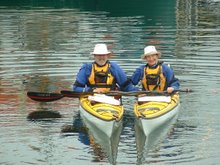This morning, it dawned cool and damp, so we decided that it was a good day to be inside = museums! Ragnhild offered to drive us to Bygdoy where several museums are located. En route, we visited her old school where she has been teaching grade 10, and her ‘brand’ new school where she will be teaching grade 8 this fall. To get to Ragnhild’s new school, we drove up and over the hill past Tanum (the old church), and through the beautiful rural countryside, and down the twisting country road on the other side of the hill. It’s amazing how quickly one can switch between residential and rural in such short distances, and still be this close in to the centre of Oslo (20 minutes by bus). The houses where Anders and Ragnhild live are nestled in a small valley with lots of trees, flowers and attractive houses. Everything is close by, i.e., train, bus, shopping, schools, churches, x-c skiing, forest to walk in, etc.
We began our museum tour today by visiting the ‘Vikingskiphuset’ which houses famous Viking ships that date back to about 800-900 AD. The Oseberg ship was built about 820 AD. It was originally used as a sailing vessel before finally being used as a burial ship for an important woman who died about 834 AD. The Gokstad ship was built about 890 AD, and eventually also used as a burial ship for a powerful chieftan about 900 AD. The Tune ship was built about 900 AD. All 3 ships, or parts of them with various artefacts were on display at the museum
From here, we walked about 1.5 kms to the ‘Norsk Rjofarts Museum’ (Maritime Museum). There was an excellent widescreen movie showing the coastal scenery and way of life along the Norwegian coast … beautiful scenery of and photography from places that we hope to visit during the next few weeks. There were many informative displays showing many types of Norwegian boats, from the oldest log boat (2200 years old, Bronze Age) to modern container ships. The ‘seafaring’ heritage of the country is well-represented by the museum.
Our next stop was the ‘Frammuseet’ which housed the Polarship ‘Fram’ and many artefacts from Arctic and Antarctic expeditions by Nansen, Amundsen, Sverdrup, and others. Norwegian explorers were some of the first visitors to the Canadian Arctic. Their exploration legacy is represented by their names throughout the Arctic Archipelego, e.g., Amundsen Sound, Sverdrup Basin, Ellef-Ringnes Island. The ‘Fram’ is a stout wooden vessel with hull planks up to 83 cm, 3 masts and a large diesel engine. It’s amazing to think of the places that this sturdy little vessel (39 m) travelled, and how she spent two winters trapped in the ice, yet sailed away, all due to her innovative ‘egg-shaped’ hull.
And then, it was on to the ‘Kon-tiki Museet’ to see the various displays that document Thor Heyerdahl’s expeditions in the Kon-tiki, Ra I and II, and Tigris across the Pacific, Atlantic and Indian oceans. It’s amazing to think that the boats used for these expeditions used materials such as balsa and papyrus.
After the museums, we took our own expedition across the cold, wind-swept harbour by boat to the downtown area, and then back to Slependen by bus.
Monday, May 21, 2007
Subscribe to:
Post Comments (Atom)

No comments:
Post a Comment